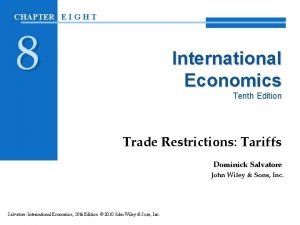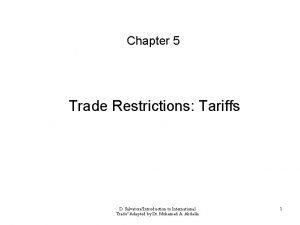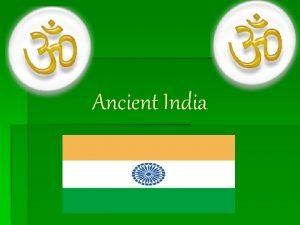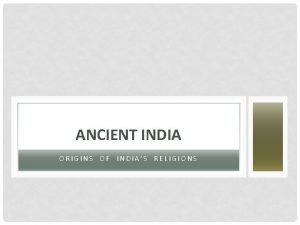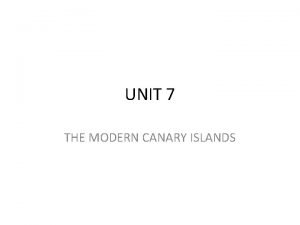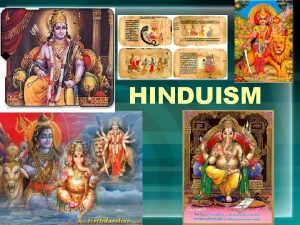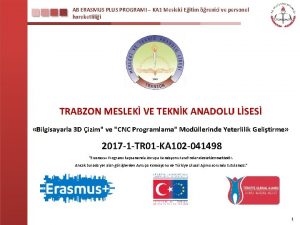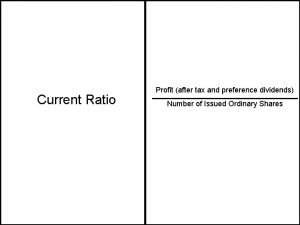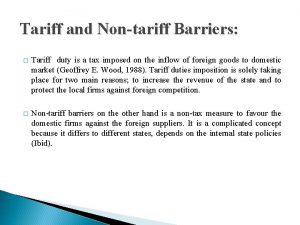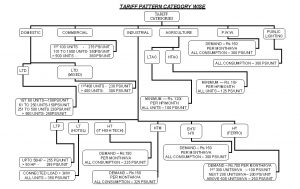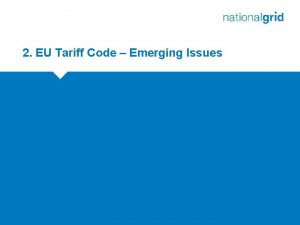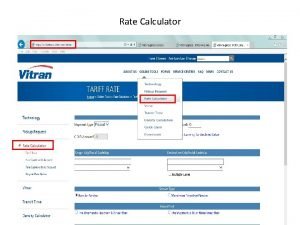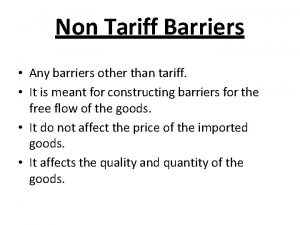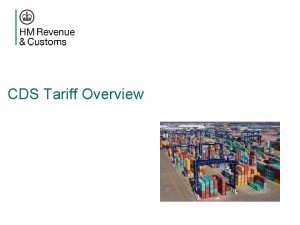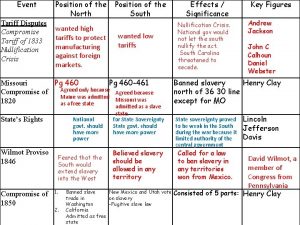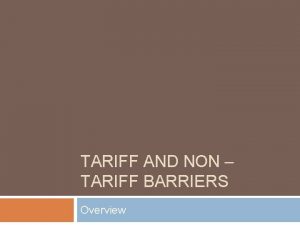Indias Duty Free Tariff Preference to LDCs A

















- Slides: 17

India’s Duty Free Tariff Preference to LDCs A Study on Non-Tariff Measures African LDCs Face in Indian Market March 2014 © Confederation of Indian Industry

Objective of the Study v To identify and analyse NTMs that African LDCs face when exporting to India under the Duty-Free Tariff Preference Scheme (DFTP) v With LDCs having poor capacity to comply with standards and other administrative requirements, the prevalence and restrictiveness of NTMs could be one reason why the dutyfree scheme has, so far, had limited success in boosting African LDC exports to India. v The study attempts to document and analyse these NTMs and offer policy recommendations for addressing them. © Confederation of Indian Industry

Methodology of the Study v This section lays out the detailed methodology adopted for identifying the NTMs in Indian market, particularly of products of export interest to African LDCs. Both primary and secondary research is used as the tools of analysis. v Since African exports to India are largely concentrated in primary products (mainly mineral fuels), the study attempts to identify potential products of export interests of African LDCs to India. v Out of the 23 African countries that have been availing India’s DFTP scheme, eight are chosen for this study, which includes Benin, Ethiopia, Mozambique, Rwanda, Senegal, Tanzania, Uganda and Zambia. © Confederation of Indian Industry

Methodology of the Study v A detailed analysis of their current trading pattern has been done to identify sector/products. In order to identify potential an attempt to understand the potential export items that these eight nations can export to India. v Tthe study classified the items of major export into thirteen categories. These items include: 1) Agricultural products, 2) Animal hides and skins, 3) Cement, 4) Fish and Fish Products, 5) Fresh or cut flowers, 6) Meat and Meat Products, 7) Metal Products, 8) Minerals & Metals, 9) Paper, 10) Petroleum and Petroleum Products, 11) Tea and Coffee, 12) Textiles and Fabrics, 13) Wood and Wood Products. © Confederation of Indian Industry

India’s Trade with African LDCs v Africa’s LDCs accounted for 26. 3% of Africa’s exports to India with a total export of US$11. 3 Billion in 2012. Amongst the LDCs Angola alone contributes more than 70% of total exports. Oil accounted for 99 percent Angola’s total exports to India. In case of total exports of African LDCs to India, oil’s share is around 80%. v Traditionally India has been importing Chemical products, Vegetable products (mainly edible vegetables and fruits & nuts), Precious stones (diamonds), Mineral products, Base metals (iron & steel and copper articles), Textile products (mainly cotton) and some Wood products from the African LDCs selected for this study. © Confederation of Indian Industry

Potential Export Items for African LDCs to India v In an attempt to identify the potential export items that these eight nations can export to India, the study classified the items of major export into thirteen categories. v These 13 product categories are those where these eight African countries are exporting to the world but do not have a significant share in Indian market. v One possible reason could be existence of NTMs which industry in Africa finds it difficult to comply with. Second reason could relate to the fact that these products from Africa have a price disadvantage in the Indian market. Another reason could be lack of awareness of the exporters in these countries that such a large market exists in India. © Confederation of Indian Industry

Non-Tariff Measures v Non-Tariff Measures (NTMs) are all measures other than normal tariffs that could potentially include trade related procedures, regulations, standards, licensing systems and even trade remedial measures such as anti-dumping, safeguards and countervailing duties. v The criteria used to classify NTMs were developed by the MAST group (Multi-Agency Support Team) which was set up to support the Group of Eminent Persons on Non-tariff Barriers established by the Secretary General of UNCTAD in 2006. © Confederation of Indian Industry

Non-Tariff Measures Technical Measures v Sanitary and Phyto-sanitary Measures v Technical Barriers to Trade v Pre-Shipment Inspection and other formalities Non-Technical Measures v Contingent Trade Protective Measures v Licensing, quota, quantity control measures, prohibitions etc v Price-control measures, including additional taxes and charges v Finance Measures v Measures affecting competition v Trade-related investment measures © Confederation of Indian Industry

Non-Tariff Measures in India v India has several import requirements on products of exports interest to Africa, which may act as NTBs to African LDCs in view of their poor capacity to comply with those standards and procedures v These regulations are in line with India’s commitments under the WTO. They cover some general import requirements as also specific requirements. v Based on the analysis of trade pattern and list of tariff lines included in India’s DFTP scheme, the study identifies 86 products for a detailed analysis of import requirements. © Confederation of Indian Industry

Non-Tariff Measures in India v Out of the total identified product lines consisting of 86 products at six digit HS classification, 51 items can be imported into India by fulfilling the conditions laid down in general import policy requirements. v The remaining list of products is permitted to be imported with additional declarations and special conditions. © Confederation of Indian Industry

General Import Requirements v As per the para 2. 2 of the Foreign Trade Policy, all imported goods shall be subject to domestic laws, acts, rules, orders, regulations, technical specifications, environmental and safety norms as applicable to domestically produced goods. v While over the years India has improved the procedures to import, there is a general perception that India’s customs normally require extensive documentation resulting in lengthy processing delays. © Confederation of Indian Industry

General Import Requirements v India has six regimes for entry of imports: (a) imports for home consumption; (b) warehousing; (c) transhipment; (d) transit; (e) re-importation; and (f) imports for special economic zones (SEZs) v As regards customs procedures India has continued the process of changing to paperless, electronic customs clearance. All importers (with a few exceptions) are required to register with the Directorate General of Foreign Trade (DGFT) and obtain an importer-exporter code (IEC) number to be able to import commercially. v Since 2007, registration has been online, through application and provision of supporting documents (e. g. bank certificate and income tax permanent number) © Confederation of Indian Industry

Pre-Shipment Inspection v Preshipment inspection for imports of certain goods has been mandatory since 2004. Goods subject to preshipment inspection include unshredded metallic waste and scrap (since 2004), and shredded metallic waste and scrap (since 2009). v Inspections ensure that consignments are free of arms, explosives, and radioactive-contaminated materials. v Imports of certain types of second-hand defective steel products, as well as textiles and clothing articles are subject to preshipment inspection on safety and health grounds. © Confederation of Indian Industry

Sector-wise NTMs v After minerals, agriculture is the second most important sector of African LDCs exports to India’s agricultural trade policy is largely guided by the principle of self-reliance. v Over the last several years, India maintained relatively high tariff and nontariff barriers to protect its agriculture. Imports constitute only around 3 percent of India’s domestic agricultural consumption. The import demands are limited to staples such as edible oils and pulses, which are undersupplied domestically. v In 2008, vegetable oils, pulses and nuts accounted for 60 percent of India’s agricultural imports. India is largely self-sufficient in a number of products including grains, oilseeds, meat, dairy products and processed foods, and imports of these products have been negligible in recent years. © Confederation of Indian Industry

Legislations Regulating Trade in Agriculture Products v Indian Plant Quarantine Order, 2003 (revised 2011) v Plants, Fruits and Seeds (Regulation of Import into India) Order, 1989 v Food Safety and Standards Act, 2006 © Confederation of Indian Industry

Product-Specific NTMs v v v v Edible Vegetables and Certain Roots and Tubers Edible Fruit and Nuts; Peel of Citrus Fruits or Melons Coffee, Tea, Mate and Spices Oil seeds and oleaginous fruits; seeds and fruit; industrial or medicinal plants; straw and fodder Lac; gums, resins and other vegetable saps and extracts Cocoa and Cocoa Preparations Salt; sulphur, earths and stones; plastering materials, lime and cement Raw hides and skins (other than furskins) and leather Wood and Articles of wood; wood charcoal Cotton Jute and other textile bast fibres, raw or retted (Chapter 53) Diamonds non-industrial unworked or simply sawn, cleaved or bruited Waste and scrap, cast iron, stainless steel, aluminum, lead waste © Confederation of Indian Industry

Thank You www. cii. in © Confederation of Indian Industry
 Ad valorem tariff vs specific tariff
Ad valorem tariff vs specific tariff Ad valorem tariff vs specific tariff
Ad valorem tariff vs specific tariff What is that ?
What is that ? What is free operant preference assessment
What is free operant preference assessment Indias first empire
Indias first empire Sociedad colonial americana
Sociedad colonial americana Indias religions
Indias religions Indias first civilization
Indias first civilization The maurya and gupta empires
The maurya and gupta empires Indias religions
Indias religions Flota de indias ruta
Flota de indias ruta Is hinduism the first religion
Is hinduism the first religion 4 castes
4 castes Heinemann duty free salzburg
Heinemann duty free salzburg Yurtdışına çıkmadan duty free
Yurtdışına çıkmadan duty free Net profit after tax and preference dividends
Net profit after tax and preference dividends Liquidity preference theory
Liquidity preference theory A preference decision in capital budgeting
A preference decision in capital budgeting
